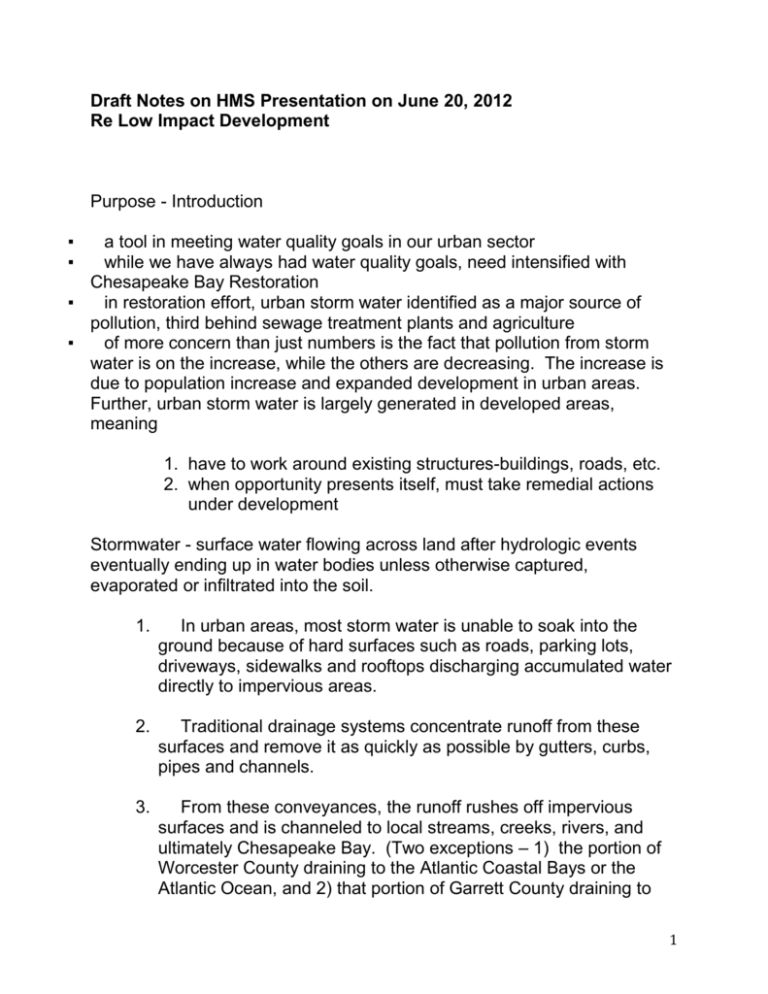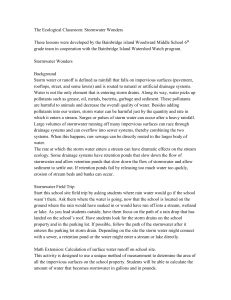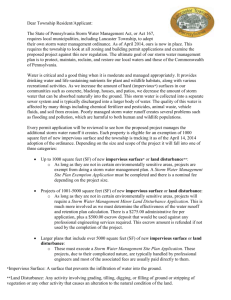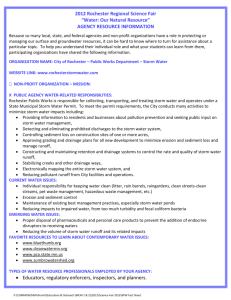raft notes for 5th Issue - Maryland Association of Soil Conservation
advertisement

Draft Notes on HMS Presentation on June 20, 2012 Re Low Impact Development Purpose - Introduction ▪ ▪ a tool in meeting water quality goals in our urban sector while we have always had water quality goals, need intensified with Chesapeake Bay Restoration ▪ in restoration effort, urban storm water identified as a major source of pollution, third behind sewage treatment plants and agriculture ▪ of more concern than just numbers is the fact that pollution from storm water is on the increase, while the others are decreasing. The increase is due to population increase and expanded development in urban areas. Further, urban storm water is largely generated in developed areas, meaning 1. have to work around existing structures-buildings, roads, etc. 2. when opportunity presents itself, must take remedial actions under development Stormwater - surface water flowing across land after hydrologic events eventually ending up in water bodies unless otherwise captured, evaporated or infiltrated into the soil. 1. In urban areas, most storm water is unable to soak into the ground because of hard surfaces such as roads, parking lots, driveways, sidewalks and rooftops discharging accumulated water directly to impervious areas. 2. Traditional drainage systems concentrate runoff from these surfaces and remove it as quickly as possible by gutters, curbs, pipes and channels. 3. From these conveyances, the runoff rushes off impervious surfaces and is channeled to local streams, creeks, rivers, and ultimately Chesapeake Bay. (Two exceptions – 1) the portion of Worcester County draining to the Atlantic Coastal Bays or the Atlantic Ocean, and 2) that portion of Garrett County draining to 1 the Ohio River Basin.) Impact of Stormwater Runoff 1. Declining water quality - storm water brings pollutants and sediment into water bodies. 2. Diminishing groundwater recharge and quality - development creates impervious surfaces that prevent natural recharge. Net decrease in groundwater recharge rates can be expected in urban watersheds. During prolonged periods of dry weather, stream flow sharply diminishes. Urban land uses and activities can degrade groundwater quality if storm water runoff is directed into the soil without adequate treatment. Certain land uses and activities are known to produce higher loads of metals and toxic chemicals - designated as "stormwater hot spots." 3. Degradation of stream channels - after development, both frequency and magnitude of stream flows increases dramatically. Stream bed and banks exposed to highly erosive flows more frequently and for longer periods, resulting in severe bank erosion and habitat degradation. 4. Increased over bank flooding - flood events that exceed the capacity of the stream channel spill out into adjacent floodplains. Termed “overbank floods” and can damage property and downstream drainage structures e.g. culverts, swales. 5. Flood plain expansion - flooding can be very destructive and can pose a threat to property and human life. Floodplains are natural flood storage areas and help to alleviate downstream flooding. Relevancy to Maryland a growing State – Projected growth will result in about 670,000 new Maryland households between 2000 and 2030. If land is developed under current land-use patterns, more than 650,000 acres (about 10% of Maryland's total land area) could be converted from farm, forest and other rural uses to residential and other urban uses. As more 2 development occurs, there is a greater risk of encroachment on water supply sources because of the greater impervious cover. More important for this discussion, development of increasing amounts of impervious surfaces reduces recharge, degrades water quality and impairs streams. Smart Growth principles of development could reduce amount of acreage lost to about 150,000 acres, about a third of what is projected under current land use patterns. (For purposes of this exercise, Smart Growth means planning development to optimize use of public fund and protection of environment. An example would be siting a new development within an area served by existing water and wastewater treatment facilities. As opposed to developing an area now in agriculture or forest that must be serviced by wells and on site treatment facilities. Public funding in generally available to expand the existing facilities.) ADDENDUM (what I left out) Common pollutant found in storm water runoff ▪ Nutrients, especially phosphorus, e.g. excessive lawn fertilizer ▪ Suspended solids from wash off of particles that are deposited on impervious surfaces and erosion of stream banks and construction sites. ▪ Organic-carbon from organic matter decomposing ▪ Bacteria – causing closure of beaches and shellfish beds; also increasing cost of treating drinking water, e.g. pet waste, geese ▪ Hydrocarbon – vehicles leaking oil and grease ▪ Trace metal – cadmium, copper, lead, zinc ▪ Pesticides ▪ Chlorides (salt) ▪ Trash Definition of floodplains - level areas bordering streams and rivers. Generally defined as the land area within the limits of the 100 year storm water elevation. Maryland law states that the 100 year floodplain is considered "waters of the State". an important management and regulating tool not only for regulating development, but also for establishing flood insurance rates by the Federal Emergency Management Agency (FEMA). Floodplains are natural storage areas and help to alleviate downstream flooding. Floodplains are very important habitat areas, encompassing 3 riparian forests, wetlands, and wildlife corridors. All local jurisdictions in Maryland now restrict or even prohibit new development in the 100-year floodplain. Development sharply increases the peak discharge rates associated with the 100-year design flows. As a consequence, elevation of a stream's 100-year floodplain becomes higher and the boundaries of the floodplain expand. In some instances, property and structures that had not previously been subject to flooding are now at risk. The 100 year storm means the size storm that statistically has a 1% chance of occurring in any given year. In this area a storm of about 7.5 inches in 24 years. In comparison a 1 year storm statistically has a 100 % chance of occurring in a given year, in this area a storm of about 2.7 inches in 24 hours. Important – we are talking about statistical principles used for planning purposes – in reality, we can have back-to-back 100 year storms. Significance of Imperviousness - Throughout discussion of management techniques, there is emphasis on minimizing impervious cover which is any material limiting the percolation of water into the sub surface. Generally, stream quality and watershed health diminish when impervious cover exceeds 10% and becomes severely degraded beyond 25%. POINT, NON-POINT SOURCES OF POLLUTION Point Source - any discernible, confined and discrete conveyance, including any pipe, ditch, channel, tunnel, etc. from which pollutants are or may be discharged. Examples include 1. 2. discharges from wastewater treatment plants. concentrated discharges from factories and industrial activities, 3. discharges from confined animal feedlot operation, 4. discharges from Municipal Separate Storm Sewer Outfall Systems (MS4s). MS4 permits are applicable in heavily urbanized jurisdictions where discrete storm water conveyances exist. The Maryland Department of the Environment (MDE) has been issuing MS4 permits required under the National Pollutant Discharge Elimination System (NPDES) to 10 populated districts in the State (Anne Arundel, Baltimore, Carroll, Charles, Harford, 4 Howard, Frederick, Montgomery, PG, Baltimore City, and to the Maryland State Highway Administration. Permit conditions include developing and maintaining programs to control storm drain system pollution (i.e. point source). Permits will require restoration of 20% of its impervious surface area not already treated to the maximum extent possible (MEP). This in addition to the 10% required in previous permits, brings the total retrofit target to 30% by 20l7. In the second phase of the program, the 20% restoration requirement will be applied to 65 smaller municipalities and State and federal properties. Estimate cost of $3+billion for the interim target strategy (2017) and $6+ billion for the final target strategy (2025). Point sources are regulated through the NPDES Program under direction of EPA although much of the day-to-day work is delegated to the State. Non-point Source Pollution - contamination that occurs when rainwater, snowmelt or irrigation moves over surfaces picks up and carries away natural and human-made pollutants and deposits them into lakes, rivers, wetlands, coastal waters and ground water. Characteristics of non-point sources of pollution: 1. Contributory contaminants and sources are diffuse and varied 2. -Pollutants discharged over a relatively wide land area. Important Point - When urban stormwater pollutants are being addressed under an MS4 permit, considered a point source. Otherwise considered a non-point source. INSTITUTIONAL ASPECTS Erosion and Sediment Control 1. l. Law written in 1970 following earlier decision that sediment is a pollutant. 2. Law requires preparation of erosion and sediment control plans, primarily in urban areas to avoid pollution during construction. 3. Applicants must submit proposed development plans to Soil Conservation Districts (SCDs) for approval. SCDs are independent entities of State government. Local grading permits contingent on 5 SCD approval of the erosion and sediment control plans. 4. Projects under 5,000 square feet and most agricultural projects exempt. 5. MDE enforces - has delegated authority to 14 counties, 8 municipalities, and the Washington Suburban Sanitary Commission. Important - SCDs, traditionally dealing with agricultural activities, taking on a major urban activity Stormwater Management 1. Current state law enacted 2007. Implementation by local governments with MDE oversight. 2. Most recent regulations (2009) provide for storm water management under Environmental Site Design - similar to Low Impact Development (to be discussed in more detail) NPDES Permit governing Stormwater Management During Construction 1. Federal requirement under Clean Water Act delegated to the State 2. Required permit for almost all activities creating a land disturbance of more than one acre 3. Includes requirements for erosion and sediment control during construction and a stormwater plan post construction. ADDENDUM Definition of stormwater management - manipulation of surface storm water runoff for the purpose of reducing or eliminating adverse impacts on water and land resources DEVELOPMENT OF MARYLAND'S STORMWATER MANAGEMENT PROGRAM The Stormwater Management Act of 2007: A State Perspective Stormwater has received an enormous amount of attention over the last couple of years due in no small measure to increases in pollution to Maryland's water resources from new and existing development. Over the coming years, runoff, the pollution it carries, and the attention both garner will continue to increase due to the anticipated expansion of the State's 6 population and the land changes that will accompany it. Managing increases in storm water, therefore, will be vital if the effects of this growth on receiving streams, rivers, and Chesapeake Bay are to be mitigated. Ensuring that the storm water management associated with future development causes no increases in water quality impacts and at the same time improves current conditions seems quite insurmountable. Fortunately, Maryland has had a program in place"…to maintain after development, as nearly as possible, the predevelopment runoff characteristics." The State's storm water management program has evolved significantly since the original statute was passed in 1982. What began as a smaller scale flood control program using dry ponds and mandated infiltration has in 30 short years (1982-2012), developed into a rather complex science replete with complicated designs, specialized construction techniques, and a want for sophisticated monitoring schemes. In this time period much has been learned regarding how best to administer an effective stormwater management program. Some lessons came through research, monitoring, and experience; others came from the hindsight gained by mistakes made. Examples are numerous. Increases in runoff volume, peak discharge, and velocity occur after development. The original storm water management program included the construction of traditional flood control detention basins to provide storage and a slow release of excess storm water to receiving stream stems. Detention basins were designed initially to mitigate the flooding impacts from large rainfall events like the 2-year and 10- year frequency storms. Unfortunately, time and experience proved this strategy to be flawed because stream channels were exposed to prolonged erosive flow conditions and the basins themselves provided little or not pollutant removal. Programmatic weaknesses taught additional valuable lessons. Wellintentioned regional storm water policies failed due to unmanaged development runoff above large facilities that sometimes never got built. Also, the need for better construction plan quality and more vigilant initial and follow up inspections of stormwater management systems became apparent. The systems constructed were being left in the hands of homeowners' associations who were then strapped with expensive, longterm maintenance obligations. These have all pushed Maryland's storm water management program to become more effective both technically and 7 administratively. Significant changes have been made to the State's law, regulations, and policies to address the knowledge gained as implementation has progressed. High infiltration practice failure, varied and misused local storm water management waiver policies, and nonspecific water quality requirements caused major revisions to the original regulations and the development of the "2000 Maryland Stormwater Design Manual" (Manual). While serving as a national template for guiding program administration, the Manual altered design philosophies to encourage managing runoff based on capturing more frequent, channel-defining storm events. Also developed were groundwater recharge and water quality volume control obligations based on project imperviousness and soil conditions. Finally, the Manual introduced nonstructural or low impact techniques to be used as credits toward the runoff volumes required to be contained by more conventional facilities like ponds and wetlands. These changes have forced the State's storm water community to consider runoff control as part of initial site planning and design. Moreover, the Manual and accompanying regulations helped further refine a rather well established storm water management program. Presently, another opportunity exists to improve Maryland's storm water management program came about with the passage of the Stormwater Management Act of 2007. Among other things, the Act requires that regulations be developed to promote "environmental site design" as much as possible. This in effect will not only expand on the techniques and credits first introduced in the Manual in 2006, but also alter design philosophies once again. Environmental site design will increase attention on how best to "…maintain after development…the predevelopment runoff characteristics." It is yet another step in the evolution of Maryland's storm water management program. With the Stormwater Management Act of 2007, Maryland mandated that all new development be designed under principles of Low Impact Development (termed Environmental Site Design or ESD) Clarification of Terminology - The Maryland Stormwater Program, as mentioned previously, is built around the principle of Environmental Site Design to the Maximum Extent Possible (ESD to the MEP). In other jurisdictions, the terminology Low Impact Development is the Terminology used. While not identical terms, for purposes of this exercise, consider the 8 two terms interchangeably. Since Pennsylvania is the host State for this year's National Environthon, and it uses LID, we will use that terminology. LOW IMPACT DEVELOPMENT LID Comprises a set of approaches and practices that are designed to reduce runoff of water and pollutants from the site at which they are generated. By means of infiltration evapotranspiration, and reuse of rainwater, LID techniques manage water and water pollutants at the source and thereby prevent or reduce the impact of development on rivers, streams, lakes, coastal waters, and ground water. LID is an approach to land development (and re-development) that works with nature to manage storm water as close to its source as possible. LID employs principles such as preserving and recreating natural landscape features, minimizing imperviousness to create functional and appealing drainage practices that treats storm water as a resource rather than a waste product. There are many practices that have been used to adhere to these principles such as bioretention facilities, rain gardens, vegetated rooftops, rain barrels, and permeable pavements. By implementing LID principles and practices, water can be managed in a way that reduces the impact of built areas and promotes the natural movement of water within an ecosystem or watershed. Applied on a broad scale, LID can maintain or restore a watershed's hydrologic and ecological functions. Goal of LID - using small scale storm water management practices, nonstructural techniques and better site planning, to mimic natural hydrologic runoff characteristics and minimize the impact of land development on water resources includes; 1. 2. 3. 4. 5. Optimizing conservation of natural features (drainage patterns, soil, vegetation) Minimizing impervious surfaces; Slowing down runoff to maintain discharge timing and to increase infiltration and evapotranspiration - maintain 100% of the average annual predevelopment groundwater recharge volume; Minimize pollutants in storm water runoff from both new development and redevelopment; and Using non structural practices or innovative technologies 9 approved by MDE. LID (ESD) Practices, Techniques Practices categorized under three major classifications: 1. ALTERNATIVE SURFACES. Use of more permeable alternatives to reduce imperviousness in residential, commercial in industrial applications. a. Green Roofs - alternative surfaces that replace conventional construction materials and include a protective covering of planting media and vegetation. Also known as vegetated roofs, roof gardens, or eco-roofs, they may be used in place of traditional flat or pitched roofs to reduce impervious cover and more closely mimic natural hydrology. b. Permeable Pavements. 3 types: porous bituminous asphalt, pervious concrete and permeable interlocking concrete pavements consist of porous surface, coarse and open graded stone base/sub base or sand drainage system c. Reinforced Turf - consists of interlocking structural units with interstitial areas for placing gravel or growing grass. 2. NONSTRUCTURAL PRACTICES - combined relatively simple features, grading and landscaping to divert runoff into vegetated areas and away from conventional storm drain systems. Runoff flows over these areas filters through the vegetation and soaks into the ground. Runoff should be conveyed as sheet flow into and through these areas (sheet flow - water usually storm runoff, flowing in a thin layer over the ground surface. Non structural practices include: a. Disconnection of non-rooftop runoff - involves directing flow from impervious surfaces onto vegetated areas where it can soak into or filter over the ground. b. Sheet flow to conservation areas - flow from developed land is directed to adjacent natural areas where it can soak into or filter over the ground. 10 3. MICRO-SCALE PRACTICES - small water quality treatment devices used to capture and treat storm water runoff from discrete impervious areas. (e.g., Less than one acre) include a. Rainwater harvesting - practices intercept and store rainfall for future use egs, cisterns and rain barrels. b. Submerged gravel wetlands - small scale filter using wetlands plants in a rock media to provide water quality treatment. c. Landscape infiltration - utilizes on site vegetative planting areas to capture, store and treat storm water runoff. d. Infiltration berms - mound of soil and stone that is placed along the contour of a relatively gentle slope. e. Dry wells - excavated pit or structural chamber filled with gravel or stone that provides temporary storage of storm water runoff from rooftops. f. Micro-bioretention - practices capture and treat runoff from discrete impervious areas by passing it through a filter bed mixture or sand, soil and vegetative matter. g. Rain gardens - shallow on excavated landscape feature or a saucershaped depression that temporarily holds runoff for a short period of time. h. Swales - channels that provide conveyance, water quality treatment, and flow attenuation of storm water runoff. i. Enhanced filters - a modification applied to specific practices (eg. micro retention) to provide water quality treatment and groundwater recharge in a single facility. Attachment provides additional information on these practices, courtesy of Calvert County Department of Public Works. 11 Benefits of Low Impact Development 1. Stormwater management becomes well integrated as a primary design consideration and can be a visual asset in site landscaping. 2. Post development runoff characteristics more closely mimics hydrology of vegetated land, reducing downstream erosive impacts. 3. Introduction of runoff back into the water cycle happens sooner and closer to the original source to ensure the continued sustainability of nearby streams, creeks, and aquifers. 4. Individual treatment facilities are often smaller and cheaper to construct than large traditional treatment ponds. 5. Quality, quantity and recharge requirements calculated as a single volume, making overall design of facilities quicker and easier 6. Once established, many of the facilities are self-maintaining. 7. Reduced frequency and duration of destructive peak overflows due to mimicry of natural hydrology. Redevelopment Under Smart Growth principles, redevelopment provides the opportunity to correct, improve an adverse stormwater runoff conditions caused by extensive impervious areas. To extent possible, existing infrastructure (storm drain pipes, utilities etc to use instead of building new. Redevelopment defined as any construction, alteration or improvement performed on sites where existing land use is commercial, industrial, institutional or multi family residential, and the existing site containing impervious are exceeding 40%. On redevelopment sites, stormwater management must: 1. Reduce existing impervious area within the limit of disturbance by 50% or 2. Implement ESD to maximum extent possible to provide water quality treatment for at least 50% of existing impervious area within limit of disturbance by 50%, or 3. Used combination of impervious area reduction and ESD implementation for at least 50% of existing impervious areas. Miscellaneous 12 Three stages review process under ESD 1. Concept Design Phase 1. Developer will identify significant natural resource and demonstrate how they will be protected. 2. Determining location of buildings, roadways, parking lots and other impervious areas 3. Consider natural drainage areas and how runoff will travel over the through the site. 2. Site Development Plan 4. Final Plan Design and Review First step key to making process work effectively. Allow participation of parties at early stage in process avoiding such situations as designing erosion and sediment control during construction that is not compatible with stormwater needs. Also a benefit to developer – doesn’t spend money on design that has to be undone. Three stage process is a major improvement over traditional procedures wherein stormwater management is often last design item. Now a more integrated process from the very beginning. Attachment 13







